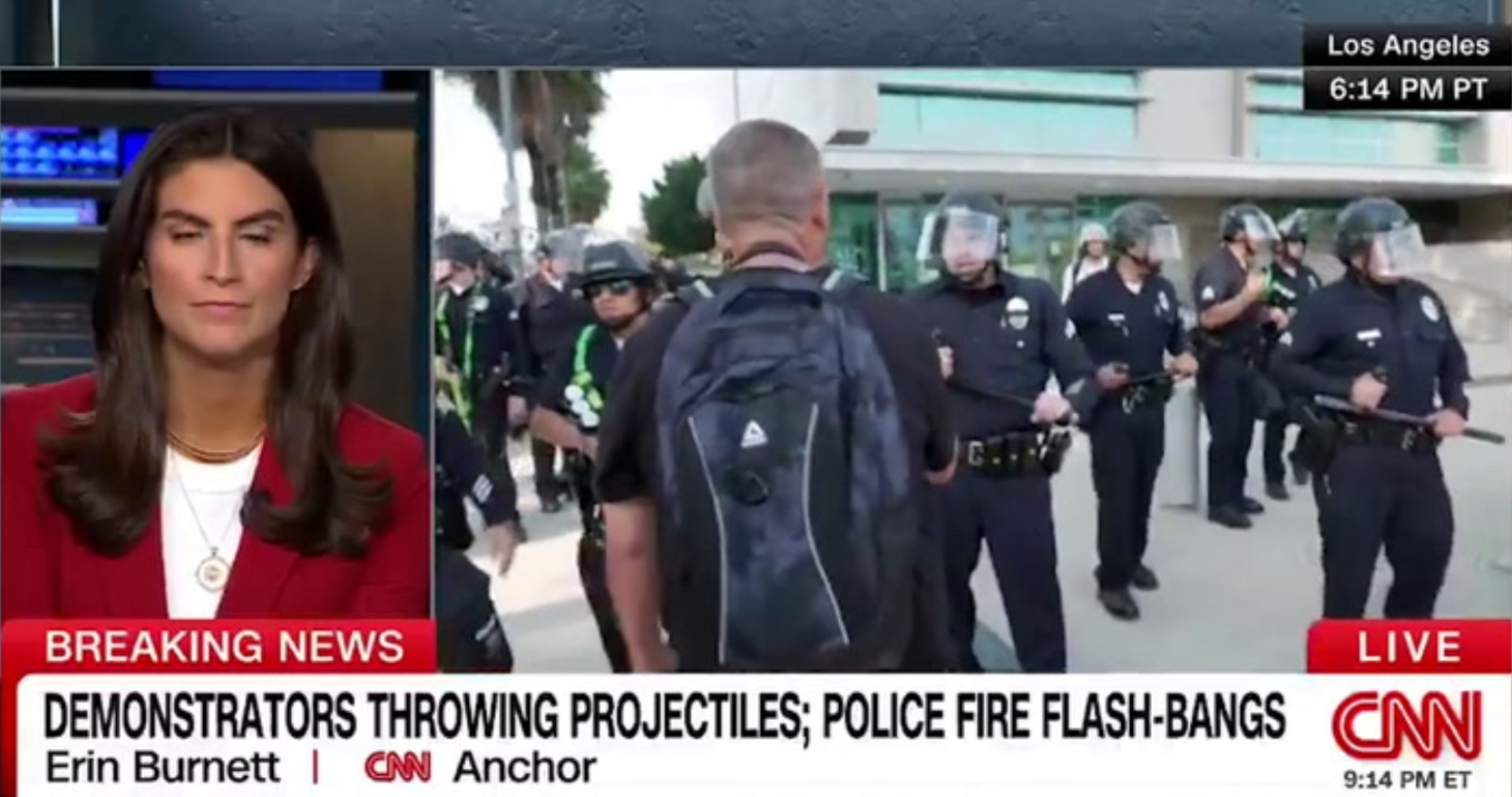Incident Highlights Tensions Between Media and Law Enforcement Amid Civil Unrest
A CNN senior investigative reporter found herself at the center of a tense confrontation with Los Angeles Police Department officers while providing live coverage of ongoing immigration-related protests in the city. The incident, which unfolded during a live television broadcast, illustrates the challenging conditions facing journalists covering civil unrest and the complex dynamics between law enforcement and media personnel in volatile situations.
The Live Broadcast Incident
CNN senior investigative reporter Kyung Lah was conducting live coverage for “The Lead” when the situation escalated rapidly. As she reported on the scene, Lah described the advancing LAPD officers who had been deployed to clear the street following a dispersal order issued by authorities.
“What you’re seeing here are the advancing LAPD. These are officers who have been called to clear this street,” Lah reported as viewers could observe a substantial contingent of police officers approaching the area. “There’s been a dispersal order issued. They’re trying to clear the street.”
The reporter and her crew initially attempted to comply with police instructions, with Lah stating on air, “Okay, we’re being asked to go behind the police,” as the CNN team repositioned themselves according to officer directions. However, the situation quickly became more complicated as officers began to separate the news crew.
Escalation and Confrontation
The tension escalated when police officers began to prevent CNN camera operators and other crew members from remaining with the reporter. Lah was heard repeatedly identifying her team members to officers, stating “Press. Press. He’s press, he’s with me. He’s with me. He’s with me,” in an attempt to keep her crew together during the coverage.
A CNN staff member also attempted to provide proper credentials, stating, “Sir, I’m with CNN. I have my verification. I have my verification right here.” Despite these attempts at identification and credential presentation, officers insisted on separating the team members.
The situation reached its peak when an officer told Lah, “He doesn’t come through. You do,” referring to her camera operator or other crew member. As officers appeared to surround the reporter, she attempted to move through what appeared to be an opening to rejoin her crew or escape the crowded situation.
The Central Allegation
The most serious moment of the confrontation occurred when an officer accused Lah of physical contact, demanding, “Are you grabbing me?” The reporter immediately and emphatically denied the accusation, shouting, “No! I didn’t touch you!” The officer then instructed her to “Get away from me!” before other officers intervened to redirect the CNN crew to a different location.
Another officer attempted to de-escalate the immediate situation by telling the CNN crew, “We need you guys to go over there. Come on,” effectively moving them away from the area of confrontation. Following the incident, Lah acknowledged the difficult reporting conditions to CNN anchor Jake Tapper, who was monitoring the situation from the network’s studios, saying, “See Jake, it’s a little chaotic.”
Context of Immigration Enforcement Operations
The incident occurred against the backdrop of intensified immigration enforcement operations conducted by Immigration and Customs Enforcement (ICE) under the Trump administration. These operations have sparked significant protests and civil unrest in Los Angeles and other cities across the country, creating challenging environments for both law enforcement and media coverage.
The protests represent community response to what the administration characterizes as necessary enforcement of immigration laws, particularly targeting individuals with criminal records. However, these operations have generated considerable controversy and opposition from immigrant advocacy groups and local communities.
Press Freedom and Law Enforcement Relations
The confrontation between CNN’s reporter and LAPD officers raises important questions about press freedom and the relationship between media personnel and law enforcement during civil unrest. Journalists covering protests and civil disturbances often find themselves in precarious positions, attempting to document events while navigating safety concerns and law enforcement directives.
The incident highlights the delicate balance between police crowd control objectives and media access rights. While law enforcement agencies have responsibilities to maintain public order and ensure safety, the press also has constitutional protections and professional obligations to inform the public about significant events.
Professional journalism organizations have long advocated for clear protocols that allow media personnel to perform their duties while respecting legitimate law enforcement operations. However, in rapidly evolving situations like the Los Angeles protests, these protocols can be difficult to implement effectively.
Broader Political Context and Public Opinion
The incident occurs within a broader political context where immigration policy has become a central national issue. Recent polling data suggests that public opinion on immigration enforcement may be more complex than traditional political narratives suggest.
According to CNN data analyst Harry Enten’s recent analysis, immigrant voters themselves have shown significant shifts in their attitudes toward immigration policy and enforcement. This demographic group, which might be expected to oppose strict enforcement measures, has actually moved substantially toward supporting more restrictive policies.
Shifting Immigrant Voter Attitudes
Enten’s analysis reveals dramatic changes in immigrant voter preferences over recent election cycles. According to his research, immigrant citizens and registered voters have experienced what he describes as “a 40-point shift to the right” on immigration issues between 2020 and 2024-2025.
This shift represents one of the most significant demographic political realignments in recent political history. The data indicates that Republicans now lead Democrats by 8 points on immigration issues among immigrant voters, a remarkable reversal from previous electoral patterns.
The analyst noted that “the group of voters who became more hawkish on immigration were in fact immigrants themselves, immigrants who were registered to vote in this country.” This finding challenges conventional assumptions about how different demographic groups respond to immigration policy debates.
Trump’s Growing Support Among Immigrant Voters
The polling data also reveals significant changes in how immigrant voters view President Trump personally. Enten’s analysis shows a steady increase in Trump’s vote share among immigrant citizens across his three presidential campaigns.
In 2016, Trump received 36 percent of the vote among immigrant citizens. This figure increased to 39 percent in 2020, and reached 47 percent in 2024. Some polling data suggests that Trump may have actually won a majority of immigrant votes in certain surveys, representing a dramatic political realignment.
As Enten observed, “There is no bloc of voters that shifted more to the right from 2020 to 2024 than immigrant voters, and Donald Trump, at least in some surveys, actually won that vote.” This shift provides political context for the administration’s confidence in pursuing aggressive immigration enforcement policies.
Changing Attitudes Toward Undocumented Immigration
The polling analysis also examined how immigrant citizens view undocumented immigrants. The data shows a significant shift in attitudes, with immigrant citizens moving from plus-23 points favorable toward undocumented immigrants in 2020 to minus-6 points unfavorable in recent polling.
This change in perspective among immigrant citizens helps explain broader public support for immigration enforcement operations, even among communities that might be expected to oppose such policies. The shift suggests that legal immigrants increasingly distinguish between their own status and that of undocumented individuals.
Political Implications for Policy Implementation
These polling trends provide important context for understanding the political environment surrounding immigration enforcement operations and the protests they generate. The data suggests that the Trump administration’s immigration policies may have broader support than media coverage sometimes indicates, including among demographic groups traditionally opposed to restrictive policies.
The political realignment also helps explain why the administration feels confident pursuing aggressive enforcement measures despite organized opposition and protest activities. The support among immigrant voters provides political cover for policies that generate significant controversy in certain communities and among advocacy organizations.
Media Coverage Challenges
The incident involving CNN’s reporter illustrates the ongoing challenges facing news organizations as they attempt to provide comprehensive coverage of contentious political issues. The physical confrontation between law enforcement and media personnel represents just one aspect of the broader difficulties in reporting on immigration enforcement operations and related protests.
News organizations must balance their responsibility to inform the public with safety concerns for their personnel. The volatile nature of immigration-related protests creates particularly challenging environments for journalists, who must navigate not only law enforcement responses but also passionate reactions from various community groups.
The incident also demonstrates how quickly situations can escalate during live coverage, leaving reporters and crews with limited options for responding to unexpected developments. The real-time nature of television news coverage can amplify these challenges, as reporters must continue performing their professional duties while managing immediate safety and legal concerns.
As immigration enforcement operations continue and protests persist, news organizations and law enforcement agencies will need to develop better protocols for ensuring both public safety and press freedom during these volatile situations.

Lila Hart is a dedicated Digital Archivist and Research Specialist with a keen eye for preserving and curating meaningful content. At TheArchivists, she specializes in organizing and managing digital archives, ensuring that valuable stories and historical moments are accessible for generations to come.
Lila earned her degree in History and Archival Studies from the University of Edinburgh, where she cultivated her passion for documenting the past and preserving cultural heritage. Her expertise lies in combining traditional archival techniques with modern digital tools, allowing her to create comprehensive and engaging collections that resonate with audiences worldwide.
At TheArchivists, Lila is known for her meticulous attention to detail and her ability to uncover hidden gems within extensive archives. Her work is praised for its depth, authenticity, and contribution to the preservation of knowledge in the digital age.
Driven by a commitment to preserving stories that matter, Lila is passionate about exploring the intersection of history and technology. Her goal is to ensure that every piece of content she handles reflects the richness of human experiences and remains a source of inspiration for years to come.
